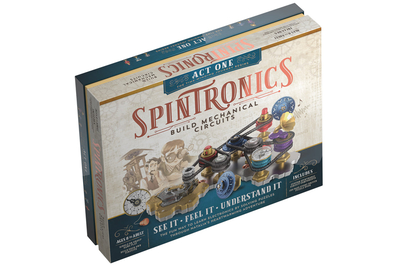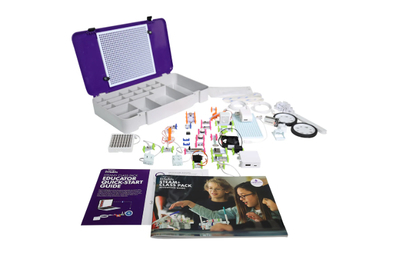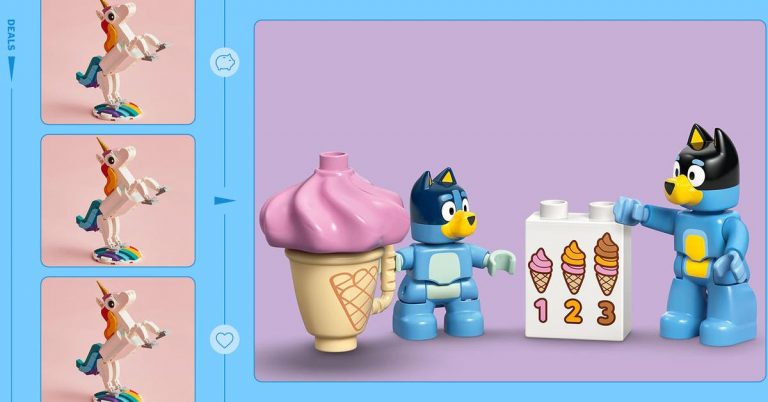Learning Toys and STEM Toys We Love
These toys help kids jump into experimenting with electronic circuitry and computing (with no soldering required). Each of these kits can be played with on its own to experiment with connections, signals, and inputs and to understand how electronic circuits and computing systems work. But the real fun comes when you use them as the electronic guts and brains for your own projects.
Spintronics Act One is one of the most original and thoughtful STEM kits we’ve tested — part engineering puzzle, part tactile metaphor for electricity. Instead of wires and electrons, this system uses tiny gears and bicycle-like chains to move mechanical energy across a circuit, mimicking how electrical current works. A pull-string “battery” winds a constant-torque spring that spins the chain forward. Resistors become stiff gears that are harder to turn. Capacitors are modeled as wind-up springs that release their energy back into the chain. Junctions split the chain to form parallel circuits. There’s even a magnetic “ammeter” (the device that measures the current in a circuit) that changes pitch depending on the speed of the chain — making voltage and resistance something you can literally feel and hear.
The Act One kit includes over 300 chain links that must be assembled, link by link. It’s a fiddly process and thankfully only necessary to do once. Once ready to go, you can loop the chains around the geared components in series and in parallel, mimicking the way current flows through electrical circuits. The kit includes 67 puzzles and a graphic novel, which follows a clockmaker’s daughter in the American frontier era who uncovers a family secret.
Spintronics is best for patient and curious upper-elementary- or middle-school-age kids who enjoy solving problems step by step. A free online simulator lets you test-drive the system before buying or check answers to puzzles when you get stumped (something the grownup testers of the game did frequently).
Recommended for ages 8 and up, LittleBits Kits are ready-made, modular circuits that snap together with magnets. Colors designate their types: blue for power sources, pink for inputs, green for outputs, and orange for wires. Kids can connect a battery-supplied power source to, say, on/off and dimmer inputs, followed by a servomotor, to see how they work together to power and modulate the speed of the motor. “I hide the instructions,” said Mike Matthews, curriculum director at Burke’s at the time of our interview, instead having students experiment with combinations and configurations on their own to learn how connections, switching, and splitters work together.
The base kit is expensive at about $480, but it comes with 10 circuits, including a power source (connected to a 9-volt battery), on/off button, dimmer switch, and servomotor (which can spin or rotate back and forth). But you can also buy LittleBit circuits à la carte, choosing from over 50 options. This opens up the real possibilities of LittleBits: Kids can use them to add motion, sound, and programming to any of their other toys and creations, whether they want to add a motor to a Lego car, smart lighting in a doll’s house, or scary sounds to papier-mâché Halloween decorations. The ready-to-go circuits may also spark a deeper interest in learning the fundamentals of circuit theory and transitioning to experimenting with breadboards and wiring on their own.
Elenco Snap Circuits let kids explore the fundamentals of electronics and circuit design by using basic components (power sources, switches, resistors, capacitors, and wires of different sizes) that snap together on a flat surface (essentially a large, easy-to-use breadboard). Kids can model various types of working circuits, follow pictorial instruction cards to create projects like radios, alarms, and doorbells, or experiment on their own.
The beauty of Snap Circuits is that, unlike kits with ready-made motors and electronic components, kids are actually building and designing real circuits (including a short circuit, if you’re not careful) — much in the same way an engineer would prototype circuits, albeit in a simplified and accessible form. The color-coded, plastic-encased components are all marked with the standard electronic symbols, which develops familiarity with symbols and values used in actual circuit design. Snap Circuits is made for kids ages 8 and up (like LittleBits), though younger kids may be able to enjoy Snap Circuits with some adult supervision.
The Kano Computer Kit is ideal for kids who have mastered Lincoln Logs, Erector, and Lego sets but aren’t quite up for soldering (or aren’t old enough for an electrical engineering degree program). The kit, which is accessible for kids as young as 6, has you assemble a small, portable computer using a Raspberry Pi 3. We know it’s a lot of money for what is effectively a $35 Raspberry Pi 3 processor and wireless keyboard, but you’re paying for the convenience of a kit that a kid can access and the accompanying apps.
The computer can pair with any display with an HDMI port, so you can use it with your TV or home monitor. The kit’s simplicity may seem limiting (the components just snap together, so it’s really more like putting together a computer than building one), but this is part of its appeal: Kids can figure out how the basic parts of a computer work together and can feel like they built it without needing to be guided by an adult.
Once assembled, kids can use the Kano computer to learn coding (with Python and JavaScript), play games (including Minecraft) on Kano’s OS, and use a number of other free apps available through Kano.
Nintendo Labo is a line of clever cardboard construction kits that bring Switch games into the real world in the form of toys you build yourself. The Labo Vehicle Kit is our top choice after we spent 25 hours researching and testing three kits before handing them off to a test panel of school-age children and their parents.
The Vehicle Kit incorporates five projects — a car steering wheel, a pedal, a key, a joystick for steering a plane, and a submarine-like contraption — into the same game, an open-map island where you can explore at your own pace. The cardboard pieces take anywhere from a few minutes to two hours to build. Following interactive building instructions displayed on the Switch’s screen, you fold the cardboard pieces along premarked lines and insert tabs into slots to make 3D shapes. The structures are ingeniously engineered; the steering wheel really turns, and the pedal pushes down. When you’re ready to use the steering wheel, you insert a cardboard key, which has one of the Joy-Con controllers inside, to pair everything with the Switch tablet. Then you’re free to steer a car around the virtual play space displayed on your television.
Thanks to its thorough instructions and seamless integration with the Switch, Nintendo Labo is a fun and approachable way for children ages 6 and up to learn about building and, if they want, programming. Labo can be a worthwhile accessory for Switch owners who want to encourage a child’s interest in STEM topics. Note: Nintendo no longer makes Labo sets, but they’re still available from some retailers.











